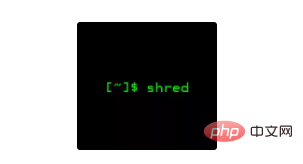Still don't know these six 'horrible” Linux commands?
Six "horrible" Linux commands
1: crypt
We have always had crypt. As the name suggests, crypt is not an underground palace or tomb for storing junk files, but a command for encrypting file contents.
Today, "crypt" is usually implemented as a script: by calling a binary program called mcrypt, which emulates the older crypt command, thereby exerting its functionality. Using the mycrypt command directly is a better option.
$ mcrypt x Enter the passphrase (maximum of 512 characters) Please use a combination of upper and lower case letters and numbers. Enter passphrase: Enter passphrase: File x was encrypted.
Please note: The mcrypt command will create a second file with the extension ".nc".
It does not overwrite the files you are encrypting. The mcrypt command has options for key size and encryption algorithm. You can also specify a key as an option, but this is discouraged by the mcrypt command.
Two: kill

There is also the kill command - of course this does not refer to murder, but refers to the termination we use How forcefully a process is ordered to terminate depends on what is needed to terminate them appropriately. Of course, Linux doesn't stop there. Instead, it has a variety of kill commands to use on your command line.
We have kill, pkill, killall, killpg, rfkill, skill (see es-kill), tgkill, tkill and xkill.
$ killall runme [1] Terminated ./runme [2] Terminated ./runme [3]- Terminated ./runme [4]+ Terminated ./runme
Three: shred

$ shred dupes.txt
$ more dupes.txt
▒oΛ▒▒9▒lm▒▒▒▒▒o▒1־▒▒f▒f▒▒▒i▒▒h^}&▒▒▒{▒▒Four: zombies
 ##Although zombies (zombie process) is not a command, it is on the Linux system But deep-rooted. Zombies are basically the remains of dead processes that have not been completely wiped out.
##Although zombies (zombie process) is not a command, it is on the Linux system But deep-rooted. Zombies are basically the remains of dead processes that have not been completely wiped out.
Processes are not supposed to run this way - leaving dead processes to linger instead of just letting them die and go to digital heaven, so the existence of zombies indicates some kind of flaw in the process that left them behind.
Check whether any zombie processes remain on your system. An easy way is to look at the title line of the top command.
very scary! There are three zombie processes shown above.
$ top top - 18:50:38 up 6 days, 6:36, 2 users, load average: 0.00, 0.00, 0.00 Tasks: 171 total, 1 running, 167 sleeping, 0 stopped, 3 zombie <== %Cpu(s): 0.0 us, 0.0 sy, 0.0 ni, 99.9 id, 0.1 wa, 0.0 hi, 0.0 si, 0.0 st KiB Mem : 2003388 total, 250840 free, 545832 used, 1206716 buff/cache KiB Swap: 9765884 total, 9765764 free, 120 used. 1156536 avail Mem
The souls of the dead will wander from sunset until late at night. Linux allows users to track whether they have left with the help of the "at midnight" command. at is used to schedule tasks to be run when the next specified time comes. It works like a one-time scheduled task (cron).
$ at midnight warning: commands will be executed using /bin/sh at> echo 'the spirits of the dead have left' at> <EOT> job 3 at Thu Oct 31 00:00:00 2017
 Linux system is also highly dependent on daemons - this kind of process runs in the background. Provides many functions of the system. Many daemons have names ending in "d". This "d" stands for "daemon", which indicates that the process is always running and supports some important function. Other daemons spell out the word "daemon."
Linux system is also highly dependent on daemons - this kind of process runs in the background. Provides many functions of the system. Many daemons have names ending in "d". This "d" stands for "daemon", which indicates that the process is always running and supports some important function. Other daemons spell out the word "daemon."
$ ps -ef | grep sshd root 1142 1 0 Oct19 ? 00:00:00 /usr/sbin/sshd -D root 25342 1142 0 18:34 ? 00:00:00 sshd: shs [priv] $ ps -ef | grep daemon | grep -v grep message+ 790 1 0 Oct19 ? 00:00:01 /usr/bin/dbus-daemon --system --address=systemd: --nofork --nopidfile --systemd-activation root 836 1 0 Oct19 ? 00:00:02 /usr/lib/accountsservice/accounts-daemon
Recommended learning: "
linux video tutorial
Hot AI Tools

Undresser.AI Undress
AI-powered app for creating realistic nude photos

AI Clothes Remover
Online AI tool for removing clothes from photos.

Undress AI Tool
Undress images for free

Clothoff.io
AI clothes remover

Video Face Swap
Swap faces in any video effortlessly with our completely free AI face swap tool!

Hot Article

Hot Tools

Notepad++7.3.1
Easy-to-use and free code editor

SublimeText3 Chinese version
Chinese version, very easy to use

Zend Studio 13.0.1
Powerful PHP integrated development environment

Dreamweaver CS6
Visual web development tools

SublimeText3 Mac version
God-level code editing software (SublimeText3)

Hot Topics
 1387
1387
 52
52
 How to use docker desktop
Apr 15, 2025 am 11:45 AM
How to use docker desktop
Apr 15, 2025 am 11:45 AM
How to use Docker Desktop? Docker Desktop is a tool for running Docker containers on local machines. The steps to use include: 1. Install Docker Desktop; 2. Start Docker Desktop; 3. Create Docker image (using Dockerfile); 4. Build Docker image (using docker build); 5. Run Docker container (using docker run).
 How to view the docker process
Apr 15, 2025 am 11:48 AM
How to view the docker process
Apr 15, 2025 am 11:48 AM
Docker process viewing method: 1. Docker CLI command: docker ps; 2. Systemd CLI command: systemctl status docker; 3. Docker Compose CLI command: docker-compose ps; 4. Process Explorer (Windows); 5. /proc directory (Linux).
 What to do if the docker image fails
Apr 15, 2025 am 11:21 AM
What to do if the docker image fails
Apr 15, 2025 am 11:21 AM
Troubleshooting steps for failed Docker image build: Check Dockerfile syntax and dependency version. Check if the build context contains the required source code and dependencies. View the build log for error details. Use the --target option to build a hierarchical phase to identify failure points. Make sure to use the latest version of Docker engine. Build the image with --t [image-name]:debug mode to debug the problem. Check disk space and make sure it is sufficient. Disable SELinux to prevent interference with the build process. Ask community platforms for help, provide Dockerfiles and build log descriptions for more specific suggestions.
 What computer configuration is required for vscode
Apr 15, 2025 pm 09:48 PM
What computer configuration is required for vscode
Apr 15, 2025 pm 09:48 PM
VS Code system requirements: Operating system: Windows 10 and above, macOS 10.12 and above, Linux distribution processor: minimum 1.6 GHz, recommended 2.0 GHz and above memory: minimum 512 MB, recommended 4 GB and above storage space: minimum 250 MB, recommended 1 GB and above other requirements: stable network connection, Xorg/Wayland (Linux)
 vscode cannot install extension
Apr 15, 2025 pm 07:18 PM
vscode cannot install extension
Apr 15, 2025 pm 07:18 PM
The reasons for the installation of VS Code extensions may be: network instability, insufficient permissions, system compatibility issues, VS Code version is too old, antivirus software or firewall interference. By checking network connections, permissions, log files, updating VS Code, disabling security software, and restarting VS Code or computers, you can gradually troubleshoot and resolve issues.
 Can vscode be used for mac
Apr 15, 2025 pm 07:36 PM
Can vscode be used for mac
Apr 15, 2025 pm 07:36 PM
VS Code is available on Mac. It has powerful extensions, Git integration, terminal and debugger, and also offers a wealth of setup options. However, for particularly large projects or highly professional development, VS Code may have performance or functional limitations.
 What is vscode What is vscode for?
Apr 15, 2025 pm 06:45 PM
What is vscode What is vscode for?
Apr 15, 2025 pm 06:45 PM
VS Code is the full name Visual Studio Code, which is a free and open source cross-platform code editor and development environment developed by Microsoft. It supports a wide range of programming languages and provides syntax highlighting, code automatic completion, code snippets and smart prompts to improve development efficiency. Through a rich extension ecosystem, users can add extensions to specific needs and languages, such as debuggers, code formatting tools, and Git integrations. VS Code also includes an intuitive debugger that helps quickly find and resolve bugs in your code.
 How to back up vscode settings and extensions
Apr 15, 2025 pm 05:18 PM
How to back up vscode settings and extensions
Apr 15, 2025 pm 05:18 PM
How to back up VS Code configurations and extensions? Manually backup the settings file: Copy the key JSON files (settings.json, keybindings.json, extensions.json) to a safe location. Take advantage of VS Code synchronization: enable synchronization with your GitHub account to automatically back up all relevant settings and extensions. Use third-party tools: Back up configurations with reliable tools and provide richer features such as version control and incremental backups.



